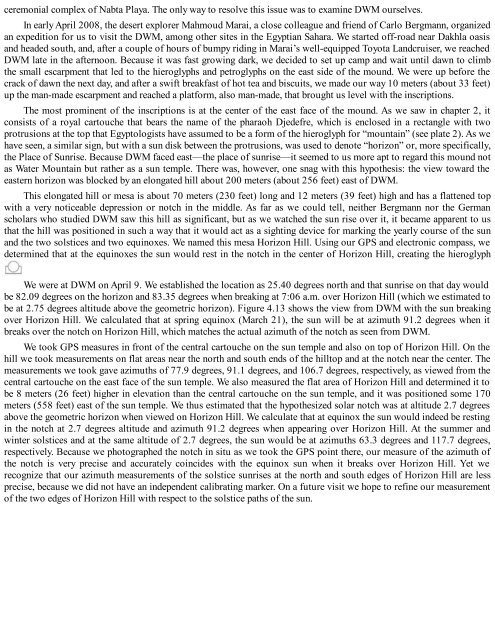Black Genesis: The Prehistoric Origins of Ancient Egypt
Black Genesis: The Prehistoric Origins of Ancient Egypt
Black Genesis: The Prehistoric Origins of Ancient Egypt
You also want an ePaper? Increase the reach of your titles
YUMPU automatically turns print PDFs into web optimized ePapers that Google loves.
ceremonial complex <strong>of</strong> Nabta Playa. <strong>The</strong> only way to resolve this issue was to examine DWM ourselves.<br />
In early April 2008, the desert explorer Mahmoud Marai, a close colleague and friend <strong>of</strong> Carlo Bergmann, organized<br />
an expedition for us to visit the DWM, among other sites in the <strong>Egypt</strong>ian Sahara. We started <strong>of</strong>f-road near Dakhla oasis<br />
and headed south, and, after a couple <strong>of</strong> hours <strong>of</strong> bumpy riding in Marai’s well-equipped Toyota Landcruiser, we reached<br />
DWM late in the afternoon. Because it was fast growing dark, we decided to set up camp and wait until dawn to climb<br />
the small escarpment that led to the hieroglyphs and petroglyphs on the east side <strong>of</strong> the mound. We were up before the<br />
crack <strong>of</strong> dawn the next day, and after a swift breakfast <strong>of</strong> hot tea and biscuits, we made our way 10 meters (about 33 feet)<br />
up the man-made escarpment and reached a platform, also man-made, that brought us level with the inscriptions.<br />
<strong>The</strong> most prominent <strong>of</strong> the inscriptions is at the center <strong>of</strong> the east face <strong>of</strong> the mound. As we saw in chapter 2, it<br />
consists <strong>of</strong> a royal cartouche that bears the name <strong>of</strong> the pharaoh Djedefre, which is enclosed in a rectangle with two<br />
protrusions at the top that <strong>Egypt</strong>ologists have assumed to be a form <strong>of</strong> the hieroglyph for “mountain” (see plate 2). As we<br />
have seen, a similar sign, but with a sun disk between the protrusions, was used to denote “horizon” or, more specifically,<br />
the Place <strong>of</strong> Sunrise. Because DWM faced east—the place <strong>of</strong> sunrise—it seemed to us more apt to regard this mound not<br />
as Water Mountain but rather as a sun temple. <strong>The</strong>re was, however, one snag with this hypothesis: the view toward the<br />
eastern horizon was blocked by an elongated hill about 200 meters (about 256 feet) east <strong>of</strong> DWM.<br />
This elongated hill or mesa is about 70 meters (230 feet) long and 12 meters (39 feet) high and has a flattened top<br />
with a very noticeable depression or notch in the middle. As far as we could tell, neither Bergmann nor the German<br />
scholars who studied DWM saw this hill as significant, but as we watched the sun rise over it, it became apparent to us<br />
that the hill was positioned in such a way that it would act as a sighting device for marking the yearly course <strong>of</strong> the sun<br />
and the two solstices and two equinoxes. We named this mesa Horizon Hill. Using our GPS and electronic compass, we<br />
determined that at the equinoxes the sun would rest in the notch in the center <strong>of</strong> Horizon Hill, creating the hieroglyph<br />
We were at DWM on April 9. We established the location as 25.40 degrees north and that sunrise on that day would<br />
be 82.09 degrees on the horizon and 83.35 degrees when breaking at 7:06 a.m. over Horizon Hill (which we estimated to<br />
be at 2.75 degrees altitude above the geometric horizon). Figure 4.13 shows the view from DWM with the sun breaking<br />
over Horizon Hill. We calculated that at spring equinox (March 21), the sun will be at azimuth 91.2 degrees when it<br />
breaks over the notch on Horizon Hill, which matches the actual azimuth <strong>of</strong> the notch as seen from DWM.<br />
We took GPS measures in front <strong>of</strong> the central cartouche on the sun temple and also on top <strong>of</strong> Horizon Hill. On the<br />
hill we took measurements on flat areas near the north and south ends <strong>of</strong> the hilltop and at the notch near the center. <strong>The</strong><br />
measurements we took gave azimuths <strong>of</strong> 77.9 degrees, 91.1 degrees, and 106.7 degrees, respectively, as viewed from the<br />
central cartouche on the east face <strong>of</strong> the sun temple. We also measured the flat area <strong>of</strong> Horizon Hill and determined it to<br />
be 8 meters (26 feet) higher in elevation than the central cartouche on the sun temple, and it was positioned some 170<br />
meters (558 feet) east <strong>of</strong> the sun temple. We thus estimated that the hypothesized solar notch was at altitude 2.7 degrees<br />
above the geometric horizon when viewed on Horizon Hill. We calculate that at equinox the sun would indeed be resting<br />
in the notch at 2.7 degrees altitude and azimuth 91.2 degrees when appearing over Horizon Hill. At the summer and<br />
winter solstices and at the same altitude <strong>of</strong> 2.7 degrees, the sun would be at azimuths 63.3 degrees and 117.7 degrees,<br />
respectively. Because we photographed the notch in situ as we took the GPS point there, our measure <strong>of</strong> the azimuth <strong>of</strong><br />
the notch is very precise and accurately coincides with the equinox sun when it breaks over Horizon Hill. Yet we<br />
recognize that our azimuth measurements <strong>of</strong> the solstice sunrises at the north and south edges <strong>of</strong> Horizon Hill are less<br />
precise, because we did not have an independent calibrating marker. On a future visit we hope to refine our measurement<br />
<strong>of</strong> the two edges <strong>of</strong> Horizon Hill with respect to the solstice paths <strong>of</strong> the sun.


